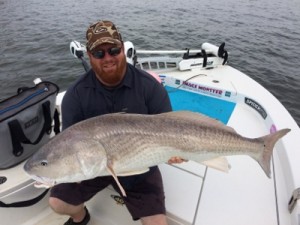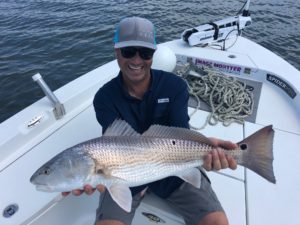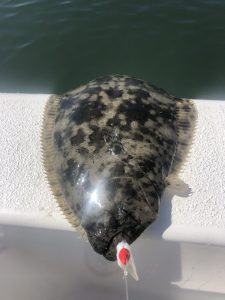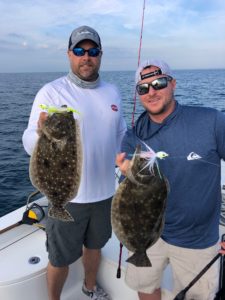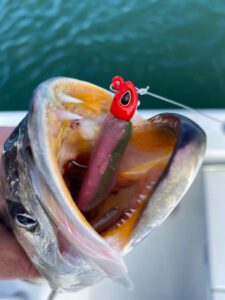
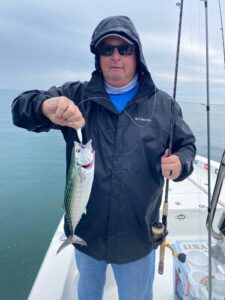
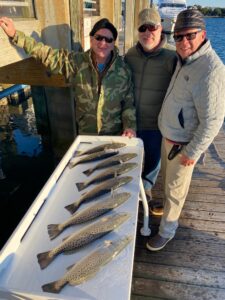
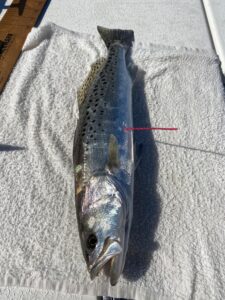
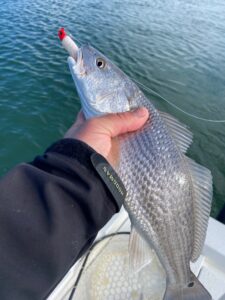
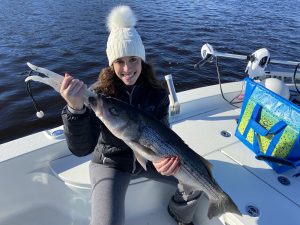
Can you believe its already December?? November just flashed by!! But hey, there is still good fishing to do around Southeast, NC! So far this fall the temps have been fair in my opinion, we are actually having a fall this year! We have had a few cool/cold days (Like this last week) but then we have runs of mild weather. This typically keeps the bite going, Fingers crossed for good weather!
In December I catch some of the biggest Speckled trout all year, but you need to know which lures work better for bigger trout. Hard baits like MirrOlures have put some big trout in the boat for me and for many other anglers over the years. One key point to trout I have found is that most days Specks will bite, but what are they eating that day? This is when you need to know where to start; what lures to try? The series I prefer are the 17MR & 22MR (Catch 2000jr) suspending, 18MR, 51M and 52MR sinking baits.
Colors; MirrOlure makes a lot of different colors but here are some of my go to colors around Southeast NC area waters. MirrOlure color codes: 11, 21, 26, 51, 704, 706, CFPR, CH, EC, HP and Capt. Jot Custom color #1 (Pink back/white belly), #2 (purple back/pink belly) and #3 (Blue back/pink belly) colors in 17MR, #1 in 22MR & 52MR (only found at Tex’s Tackle shop) Any local tackle shop can help you with these color codes or at MirrOlure.com. Fishing Depths to use these lures; 17MR & 22MR use these lures in two to six feet of water (suspending). 18MR, 51M & 52MR use these lures in four to fifth teen plus feet of water with current (sinking). If your lure is hitting the bottom go to a shallower running lure (suspending type).
If you have ever done any trout fishing at all you know that the grub/jig (soft plastic) lures work very well for Speckled trout. Good looking scented lures that have been working very well for me lately are Berkley Gulp three-inch shrimp and five-inch Jerkshad. Gulp comes in many colors, but here is a few that I like for trout in (shrimp pattern); sugar spice glow, pearl white, Sangria & Scooby. The new chrome series of Gulp baits have really caught my eye. I have only used them a little bit by so far good results.
Keep your eyes peeled for the new Saltwater Berkley PowerBait series I worked on this project, and I am really excited about these lures! There are eight new shapes in this series and a new saltwater scent: different from the regular PowerBait scent. I am really liking the Bonga Shad, Bonga Shrimp and Bonga Stick of this series! These baits are in stores now!
I rig all my trout soft plastic lures on 1/16oz, 1/8oz and 1/4oz jigs heads in colors red, gray, or white and I always use a fluorocarbon leader when trout fishing. I prefer Berkley Pro Spec twenty pound in clear, thirty pound if the blues show up in numbers.
Do not count out live bait if you enjoy fishing with it. Try live smaller mullets (when their legal to use), mud minnows and live shrimp. In shallow waters of two to six feet I like to float these live baits with a cork and a small treble hook. In deeper waters of six to ten plus I rig them on light Carolina rigs with a small #1 or #2 Eagle claw L42 offset circle hook. Just wait until you feel that trout take off with the bait and lightly set the hook, remember trout have very soft mouths fast hooks sets but with light power work best.
In December another fish I really like to hunt for on sunny, warmer, and light wind days is schooling Redfish. I find these schools on oyster rocks/flats, sand bars in the surf and shallow flats just off the ICW. In December the Reds are not hard to catch when you find them, but sometimes finding them can be a challenge. My go to bait for the winter Redfish are scented grub like the Berkley Gulp jerkshad or shrimp; Redfish love these things. Rig grubs with thirty-pound fluorocarbon and a darker colored jig heads like red or gray should get the redfish to bite for you. Sometimes a light Carolina rig with a small piece of cut shrimp; for those stubborn fall/winter Redfish may help get a bite.
Just a little inland in Southeast, NC runs the Cape Fear River and in the Cape Fear there is one of my favorite winter fisheries, the Striped Bass. These fish are not the easiest to catch, but they fight very well even in cold water. Working drop offs and grass lines on the edge of the river is where you can find the Stripers, using swim bait lures like Berkley Power Bait Grass pig lures and Berkley Gulp Jerkshad. These lures should put a few Cape Fear Stripers on your line. I rig these lures on swimbait hooks for weedless fishing, (lots of hangs in the river). I use TroKar TK170 and TK178 swimbait hooks, super sharp! Do not forget that the Cape Fear River Striped Bass Fishery is closed; catch and release only!
Tackle run down: PENN Battle III DX and New Authority Spinning reels in sizes 2000, 2500, 3000 & 3500. Low profile PENN Fathom 200 size, if that is your game! Fishing for Redfish, Speckled trout, and Striped Bass Rods: Fenwick Inshore HMG 7’& 7’6” med/light (Speckled Trout) and medium action (Redfish & Striped Bass); line Spiderwire Ultra-cast in eight- or ten-pound test for Speckled trout fishing and ten and fifth-teen pound for Reds/Stripers.
Thanks for reading, Merry Christmas, Happy New Year, and good winter fishing to you!
Capt. Jot Owens
www.captainjot.com
910-233-4139
Posted in Fishing Reports on December 4th, 2023
September is the month of change; summer starts to wind down and fall starts to show itself. I personally really like to fish in September, warm days, a little less humidity, much less boat traffic and best of all; great fishing! Here are some of the “goto” fish I like to target during September. Also, during September, the mullet run starts to get going, this always helps the fishing!
September is NC Flounder season. *Keeper North Carolina Flounder season for 2023 at the time of this report is September 15th to September 29th in coastal waters. Any Flounder caught outside of these dates must be released. Working live bait or artificial lures are both good ways to catch flounder. Live bait is good for catching higher numbers of Flounder, but not always as many larger size flounder with live bait for me. Mud minnows and small finger mullet will be the best live baits for Flounder in September. Small menhaden work too but die very easy in the warm waters of September.
Rigging the live bait on carolina rigs with Eagle Claw L42 sizes 1 or 1/0 hooks is a good choice of rigs for Flounder. If you prefer to use artificial baits which I see bigger size flounders more often on artificial lures. Scented and unscented soft plastics work well in clear or stained waters. Berkley Gulp Jerkshad in five and six inch and colors of new penny, pearl white, fire tiger and chart pepper neon are all good too. Darker colors like new penny and fire tiger (bright but not bright?) in heavy stained/dirty waters work better to get more bites. Also try Berkley’s Powerbait Grass Pig lure in colors, chartreuse, crazy chrome violet, and swamp gas (new penny). I rig all of these lures on jig heads in 1/4oz, 3/8oz and 1/2oz weights in colors red, gray, or white. Another “set” of colors that is just hitting the tackle shops is the Chrome series of Gulp baits. I tested some of these baits last year and had good luck with inshore Flounder and Redfish. I prefer all chrome, purple chrome, and red chrome. There are some even newer Chrome series colors hitting the tackle shops now!! Keep your eyes peeled for my new favorite color, Dazzleberry Chrome!!
Look for the bigger flounder around deeper water docks with good current, bait fish and lots of structure inshore. The inlets, offshore reef and ledges are all good places to find hot weather flounder. What do all these places have in common, deeper water, current and structure. Do not forget look for the clearest water possible and when fishing very stained/dirty water slow down your presentation of the bait.
When the water starts to cool down the Redfishing (Red Drum) will heat up. I look for the Reds to be in the creeks, along the ICW docks and oyster rocks. Anywhere bait is moving by! Carolina rigs with live bait or fresh cut bait is a good bet to catch a Redfish. If you want to go the artificial root, try Berkley Gulp three- or four-inch shrimp in colors sugar spice glow or sangria rigged on a 1/8oz or 1/4oz jig head should get’em to bite. Early mornings or late afternoons the top water bite should be good; cast MirrOlure Top Dog Jr’s and Top Pup’s for the best bite. Look for the top-water reds to be along marsh grass lines and shallow oyster rocks. You can also use rattling or popping corks in the same areas you use top-water plugs, just rig them with eight to fourteen inches of forty-pound fluorocarbon, 1/0 hook L42 Eagle Claw and a live figure mullet.
The bigger Reds are starting to show up in the ocean on hard bottoms and around the inlets. You never know when you might hook one of these hard fighting fish. When I fish for bigger Reds, I use fresh cut or live menhaden and mullet. I use carolina rigs with TroKar TK5 8/0 or 9/0 AP circle hooks and eighty-pound clear Berkley Big game mono leaders. Don’t forget to keep your drag tight when using circle hook so the hook will do its job. One tip I can give you when fishing for Bull (Old) Reds, is don’t use to light of tackle for these bigger Reds. If you fight them to long, there is a chance you can tire them out too much and kill them. Try a med/heavy rod and a reel with at least thirty-pound mono or braid, this will help you get the fish in quicker; with a better chance of a good release. Check to see if the Drum has a yellow tag in its back; there are a fair amount of tagged Big Reds out there.
Spanish mackerel and false albacore fishing can be great during September. The Spanish run the biggest (in size) all year during the fall. You can cast or troll for them and the fly fishing can be great as well. The Spanish/albacore will be around the inlets, up & down the beaches and near shore artificial reefs. Look for jumping Spanish and diving birds; that is where you need to fish. Casting small spoons like Big Nic Spanish candies on light spinning tackle will put some Spanish in the boat for you. Keep your eye peeled in local tackle shops for my new custom 1.5oz Spanish Candy Capt. Jot custom color! If you would rather troll, give a Blue Water Candy Daisy Chain a try on top and a #1 planner down deep with a Clark spoon. If you would like to give fly fishing a try, use a six to eight weight set up with floating line with a small minnow pattern fly or epoxy minnow pattern: my favorite!
Shark fishing will be good until late September. I see lots of different kinds of Sharks in September; Black tip, black nose, Sandbar, Hammerhead and Tiger. Best baits for the near shore sharks are fresh/live Bluefish, Mullet and Menhaden. I use spinning or conventional reels for Shark fishing with 300+ yards of fifty- and sixty-five-pound Spider wire Ultra-cast braid. Rigging the baits; eight feet of 80-pound mono leader; some of this leader will wind on to the reel. Connected to the 80-pound mono with a fifty-pound swivel, then Two to three foot of #9 SS wire and a TroKar 8/0 or 9/0 AP circle hook. (I push down the barb for easy release) If you prefer Fly fishing, I like Striped bass flies in Menhaden patterns with 4/0 and 5/0 hook sizes. We use ten to twelve plus weight set ups; have lots of extra flies with you!
Fishing Tackle I use: PENN Authority series reels 2500 & 3500 for Redfish, Flounder, and casting to Spanish mackerel. Big Drum and Sharks PENN Slammer IV or Authority5500 or 6500 series spinning reels or conventional Fathom II 20LW reels. Rods PENN Battalion II or Fenwick HMG Inshore 8 to 15 pound 7’ class for Redfish and Spanish mackerel. Big Drum and Sharks PENN Rampage jigging spinning or casting 30-to-80-pound class. Lines Light tackle Redfish and Spanish/albacore Spiderwire Ultra-cast 10-to-15-pound, Big Drum and Sharks 30-pound Berkley Pro Spec Chrome mono on conventional reels or Spiderwire braid 50 to 65 pound on spinning reels. Tackle storage: Plano Guide or Z series tackle bags with EDGE boxes inside.
Good September fishing to you and thanks for reading!
Capt. Jot Owens
www.captainjot.com
910-233-4139
Posted in Fishing Reports on September 3rd, 2023
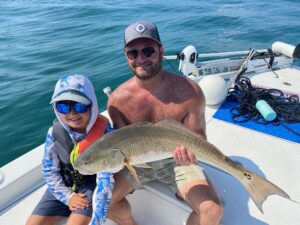
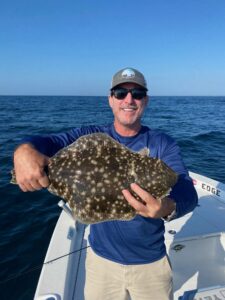
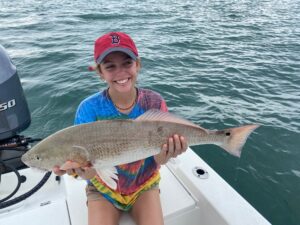
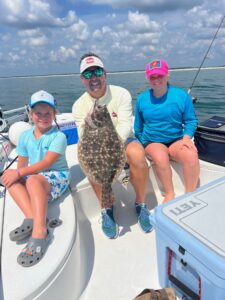
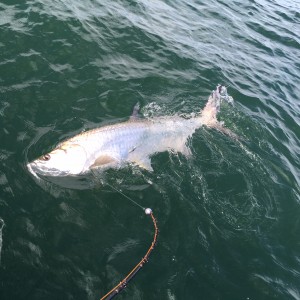
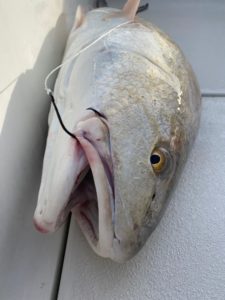
August fishing in southeast NC can be pretty good but a few things to keep in mind. Most August’s we must watch the water temps, they can get high during August. Also, we sometimes get very heavy rain/thunderstorms which can dirty up the waters quickly and this dirty water can last a few hours to a few days. Here are my warm waters and stained waters August fishing tactics.
Flounder can be a tougher species to catch in dirty water, but keep in mind they still must eat too! Working live or artificial lures slower so the flounder have time to see and react to the target (bait). Live bait is good for catching higher numbers of Flounder, but no always as many larger size flounder with live bait. Mud minnows and small finger mullet will be the best live baits for Flounder in August. Small menhaden work too but die very easy in the warm waters of August.
Rigging the live bait on carolina rigs with Eagle Claw L42 sizes 1 or 1/0 hooks is a good choice of rigs for Flounder. If you prefer to use artificial baits which I do prefer and I see bigger size flounders more often on artificial lures. Scented and unscented grubs work well in clear or stained waters. Berkley Gulp Jerkshad in five and six inch and colors of new penny, pearl white, fire tiger and chart pepper neon are all good too. Darker colors like new penny and fire tiger (bright but not bright?) in heavy stained/dirty waters work better to get more bites. Also try Berkley’s Powerbait Grass Pig lure in colors, chartreuse, crazy chrome violet, and swamp gas (new penny). I rig these lures on jig heads in 1/4oz, 3/8oz and 1/2oz weights in colors red, gray, or white. Another “set” of colors that is just hitting the tackle shows is the Chrome series of Gulp baits. I tested some of these baits last year and had good luck with inshore Flounder and Redfish. I prefer the all chrome, purple chrome, and red chrome. PS: word is there is some more chrome series colors coming out soon…stay tuned!!
Look for the bigger flounder around deeper water docks with good current, bait fish and lots of structure inshore. The inlets, offshore reef and ledges are all good places to find hot weather flounder. What do all these places have in common; deeper water, current and structure. Do not forget look for the clearest water possible and when fishing very stained/dirty water slow down your presentation of the bait. *Keeper North Carolina Flounder season for 2023 at the time of this report is September 15th to September 29th. Any Flounder caught outside of these dates must be released.
One fish that is always on my hot weather and stained waters list is the Sheephead. The Sheephead is a good challenge to catch and they fight hard, but they are also good to eat! All you need is some fiddler crabs or sand fleas for bait. A medium/heavy action spinning or casting rod with Spiderwire twenty- or thirty-pound braid for line will help you bring in that big Sheephead in. Tie on a short carolina rig with forty- or fifty-pound fluorocarbon leader and a small live bait J hook (sharp/strong)! Another rig I have been having success with is a NC treat jig rig for Sheephead fishing. Drop that fiddler crab down beside a piling on one of these rigs and when you feel that little bump; set the hook and hold on! PS: they are great eating in the two-to-eight-pound range in my opinion.
North Carolina is not really known highly for Tarpon fishing but I do see them pushing just off the southeast inlets and the lower Cape Fear River from time to time. If you want a good challenge, give Carolina Tarpon fishing a try this August. The best times are very early morning or late afternoon and into the night. I fish for Tarpon on the bottom or free lining, using live and fresh dead baits like; spots, mullet, and menhaden. I rig these baits on fish finder rigs, with one to three feet of 80-to-100-pound fluorocarbon leaders. Circle hooks are the best bet for good hook ups and landings for Tarpon in hook sizes 7/0 to 9/0 depending what hook series you like. I prefer TroKar AP TK5 9/0 circle hooks, super sharp and super strong! It is not easy to catch a NC Tarpon, but I promise if you do or even just jump one off its still really cool to see!
I also enjoy shark fishing later in the summer (late July to early September). Sharks on light tackle are always a good pull and boy the kids love to catch’em! Sharks do not really seem to care if the water is dirty either. I drift live and fresh dead bluefish, Spanish mackerel, mullet, or menhaden in twenty to forty feet of water offshore. I rig these baits with a 7/0 to 9/0 TroKar circle hook TK5 with one foot of ninety pound plus wire and six to eight feet of eighty-pound mono leader. You can free line the bait and /or put a small egg sinker on to keep the bait close to the bottom. You will know when you get a bite! Most sharks are in the ten-to-one-hundred-pound range.
Last but certainly not lest is Bull Redfish (big Red Drum). The Bull Reds will start showing up in good numbers around inlets and hard/live bottoms just off the beach to about ten miles out in early August. Live or fresh dead bait is the key to catching these brutes. Most fish will be twenty-eight to over forty inches in length, very fun to catch size! It is not hard to rig for the Bull reds; short carolina rigs with a 7/0 to 9/0 TroKar circle hook will do the trick. Live or fresh cut Menhaden or mullet as bait. Remember if your catching larger Drum, please use heavier tackle; these Drum will work so hard when the water is hot and it is easy to kill them using to light of tackle (fighting them to long). *Please take the time to revive Red drum especially bigger fish during warmer water months; it may take upwards of fifteen minutes to do so.
Tackle run down: PENN Slammer IV & (New series) Authority spinning reels 2500, 3000, 3500 sizes for the Sheephead and Flounder. Tarpon/Sharks/Bull Drum PENN Slammer IV & Authority 5500 & 6500 and PENN 20 Fathom II LW casting reels. Rods Fenwick HMG Inshore spinning 7’ medium and med/heavy for the Sheephead and Flounder. Tarpon/Shark/Bull Drum Rods: PENN Carnage III 40 to 80 Boat series. Line Spiderwire Ultra-cast in ten and fifth-teen pound and Berkley Pro Spec Chrome mono in thirty pound for the Tarpon/sharks. Tackle Storage I prefer Plano Guide and Z-series tackle bags with EDGE Boxes inside.
Have a good August, stay cool and dry, thanks for reading! Good fishing to You!
Capt. Jot Owens
www.captainjot.com
910-233-4139
Posted in Fishing Reports on August 2nd, 2023

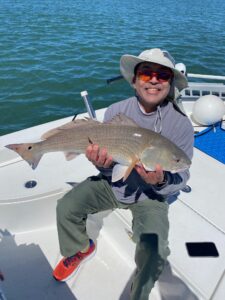
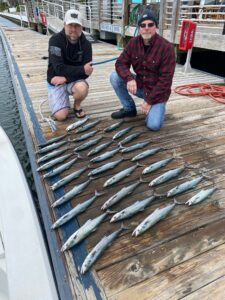
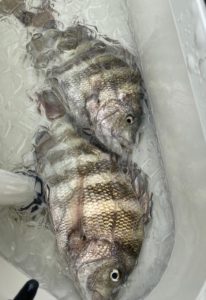
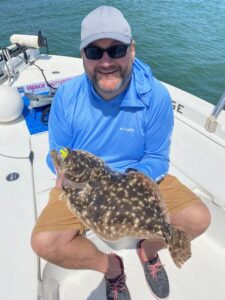
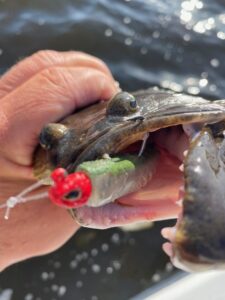
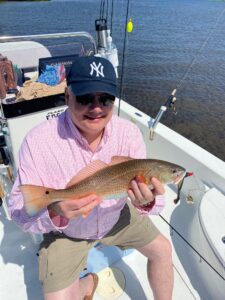
June, one of the better fishing months in Southeast NC; lighter winds (hopefully), warm days and so many kinds of fish to target. Precipitation anybody’s guess, some June’s super dry; some June’s monsoon! Here are some of the fish I like to target during June around Southeast NC.
Redfish are in their summer trend by June and the trick to summer Reds is to find the fish that have not been pressured too much. For this I like to use search type lures. Top water lures and rattling corks (popping) in the shallow waters earlier mornings and afternoons will produce Redfish. I prefer MirrOlure Top dog Jr or Top Pup’s with a great ‘walk the dog action with sound,’ fishing these along marsh grass edges with oyster rocks. Working grubs like Berkley Gulp later in the day will also produce Reds for you, fishing deeper holes and docks (fishing deeper with the sun high). Slow rolling swimbaits like a Berkley Powerbait Champ swimmer or Grass pigs rigged on TroKar 7/0 1/4oz swimbait hooks in two to five feet of water has produced some nice Reds. Keep in mind just because you find the Redfish, does not always mean they will bite. Hey someone could have pressured those same fish the day before or just before you got there. Covering area will help you find the biting or less pressured fish.
Everybody loves to catch a Flounder; they are really getting their act together by June. Keep in mind you can fish for Flounder but the season is closed in NC; you must release all flounder. Check with NCDMF for current set Flounder season (at the time of this report the 2023 season had not been set). You can find Flounder just about anywhere when June rolls in. In southeast NC, I look for bigger Flounder around deeper channel drop-offs; in waters of five to fifth-teen feet plus deep. The local inlets and cuts; south Topsail, Rich’s, Mason’s, Masonboro, Carolina Beach and snow’s cut are always a good place to find some bigger size Flounders. Last but certainly not least, are the artificial reefs, ledges, and hard/live bottoms from one to ten miles off the beach, these areas always hold very nice Flounder in June.
Once you have found some Flounder you need to know how to catch’em. If you want to go the artificial root, try bigger baits; this will greatly help you catch bigger size Flounder. I prefer Berkley Gulp five- and six-inch Jerkshad in colors pearl white, chart pepper neon and Fire tiger. Also, Berkley Powerbait Grass pig lures in colors Chartreuse silver fleck, green back or crazy chrome violet. Rigging both the jerkshad and grass pig lures on 3/4oz to 1oz jig heads or Berkley Fusion bucktails in 1oz or 1.5oz for ocean fishing. Another great Flounder lure is the Berkley Gulp four-inch shrimp pattern; this bait is great for cast up and down inshore drop-offs in creek channels. I rig these baits on jig heads in sizes 1/4oz to 3/8oz for inshore; in colors red, gray, and white. Leaders; inshore thirty or forty pound and ocean fishing forty- or fifty-pound Berkley Pro Spec fluorocarbon leader.
If you would like to go with live bait for the Flounders, try mud minnows, small mullets, or small menhaden as live bait. Rig these live baits on Carolina rigs with an Eagle Claw L42 #1 or 1/0 hooks, eight to fourteen inches of thirty-to-forty-pound fluorocarbon as leader. I prefer egg sinkers as my weight, the secret to how much weight you use is ‘as much as you need to stay on the bottom but as least as you can get away with.’ You need to be on the bottom for Flounder but going lighter will always get you more bites!
One fish that is always on my hot weather list is the Sheephead. The Sheephead is a good challenge to catch and they fight hard, but they are also good to eat! All you need is some fiddler crabs or sand fleas for bait. A medium/heavy action spinning or casting rod with Spiderwire twenty- or thirty-pound braid for line will help you bring in that big Sheephead in. Tie on a short carolina rig with forty- or fifty-pound fluorocarbon leader and a small live bait J hook (sharp/strong). Also, I’ve had good luck rigging up a carolina Treat jig with a fiddler crab. Drop that fiddler crab down beside a piling on the carolina rig and when you feel that little bump; set the hook and hold on! PS: they are great eating in the two-to-six-pound range!
The Spanish mackerel fishing can be pretty good in June. These fish are a lot of fun to see busting the surface of the water and even more fun to see on the end of your line! Casting small spoons like (Big Nic Spanish Candy lures) or using fly gear in weights seven to nine can make for a great challenge on this light tackle. Look for Spanish to be hanging around near shore artificial reefs, ledges, and inlets. Trolling Clark spoons or small deep driver lures can be the key to success some days for the Spanish mackerel and even king mackerel. When using the Clark spoons, I would recommend the pink flash or regular silver spoons in sizes #00, #0 and #1; the pink flash series has really helped me put more fish in the boat. You might come over a few false albacore and bluefish mixed in with the Spanish from time to time.
Last but never least; Cobia fishing is in full swing by early June and should be good until early July; so far this year it has been hit or miss for me. I look for Cobia around inlets, shoals, and bait schools; near shore/offshore reefs and ledges are also a good place to look too. With the water being clear most of the time in June it should easier to see those brown logs swimming in the water. I like to throw big jigs, swim baits and live bait to the Cobia. Color really does not seem to matter, but (go bright); Berkley Fusion Bucktails in 1.5oz to 2oz, but I always add a Berkley Gulp 5-inch grub. When I am not sight casting for them, we are fishing around inlets, shoals, and near shore artificial reefs. I float fish, bottom fish, and kite fish in these areas with live menhaden, spots, and mullet as bait. You can chum if you like, but the sharks and Rays will come in numbers!
Tackle run down: PENN Battle III DX, Slammer IV or Authority series spinning reels 2500, 3000 & 3500 sizes for the Redfish, Spanish, sheephead and Flounder. Cobia: PENN Slammer IV or Authority 5500 & 6500 spinning reels or PENN 20LW, 25LW, 25NLD Fathom casting reels. Rods PENN Battalion II or the Fenwick HMG Inshore series; 7’ medium and med/heavy for the Redfish, sheephead and Flounder. Cobia Rods: PENN Rampage or Carnage III Jigging series 50 to 100 class casting and spinning. Line Spiderwire Ultra-cast in ten and fifth-teen, twenty (ocean flounder) pound braid and Berkley Pro Spec Chrome mono in twenty and thirty pound for the Cobia; it is great line! Leader material Berkley Pro Spec Fluorocarbon 30 to 40 pound for inshore and 80-pound Cobia fishing. Tackle storage Plano Z-series or Guide series tackle bags with Plano EDGE stowaway boxes.
Stay cool and enjoy your summer fishing! Thanks for reading!
Capt. Jot Owens
www.captainjot.com
Posted in Fishing Reports on May 31st, 2023



















